To Vaccinate or Not to Vaccinate
Editor: Rachel Horak
Published online:
Abstract
To vaccinate or not to vaccinate, that is the question. Much of the recent trend in society against vaccination is that the general population does not understand 1) how vaccines work and 2) how one's vaccination status can influence others. Further compounding this is rather low acceptance of the influenza vaccine, a vaccine which is sometimes not even effective against the strains predominantly in circulation. Through engaging in a conversation about the role of vaccines in immunity not only of oneself but also about surrounding persons, we can increase vaccine acceptance. Herein is a physical assay which illustrates the concept of herd immunity with differing levels of vaccinations within a population. Students will learn that low vaccination rates do little to nothing to stop disease spread and that a large portion of the population (80%) is necessary to achieve near-eradication. This lesson is able to be taught at multiple levels using supplies that can mostly be obtained at the grocery store. In addition to illustrating vaccination, this study approximates a direct enzyme-linked immunosorbent assay (ELISA), enabling students to better understand that technique and how it is used to diagnose disease as well as the interrelation between antigens and antibodies.
Citation
Harley CM, Edgerton J, Auletta A. 2020. To vaccinate or not to vaccinate. CourseSource. https://doi.org/10.24918/cs.2020.13
Lesson Learning Goals
Students will:
- Understand the way that exposure levels and frequency influence the spread of disease
- Understand the concept of 'herd immunity'
- Value the importance of vaccines
- Develop an understanding of the concepts of antibody and antigen as they relate to disease
- Describe how a direct ELISA can be used to monitor infection within a population
Lesson Learning Objectives
Students will be able to:
- Describe the effect of exposure frequency on disease transmission
- Explain the concept of herd immunity
- Defend the importance of vaccines
- Describe the role of vaccination in immunity
- Explain what a direct ELISA is and how it can be used to diagnose infection
Article Context
Course
Article Type
Course Level
Bloom's Cognitive Level
Vision and Change Core Competencies
Vision and Change Core Concepts
Class Type
Class Size
Audience
Lesson Length
Pedagogical Approaches
Principles of How People Learn
Assessment Type
INTRODUCTION
In the past 30 years there has been increasing resistance to vaccination for various social, cultural, and religious reasons (1-4). Much of this is due to a misunderstanding of how vaccines work and why they are effective (3,5,6). Recently, this failure of some to vaccinate their children has resulted in a rise in outbreaks of diseases such as measles, mumps, and polio (7,8). This lesson was created with the goal of educating students with variable background knowledge about epidemiology and herd immunity (7,9). When people understand the mechanism of vaccination action as well as the influence that their choice to vaccinate has on others, they are more likely to seek out vaccinations (5,10,11). By teaching students about vaccination, we enable them to become 'science ambassadors' who can disseminate this information to others, a necessary condition for the emergence of effective herd immunity.
While it is commonplace in many courses such as Anatomy and Physiology, Introductory Biology, and Microbiology to teach students about the process of creating antibodies and disease spread; it is far less common to be able to demonstrate the effects of herd immunity. This exercise is based on one which was used for reproductive health classes to teach students about the spread of sexually transmitted diseases. There are a multitude of examples of this lesson online. For examples see these links:
- https://us.vwr.com/store/product/10424349/ward-s-simulated-disease-transmission-lab-activity
- http://peabody.yale.edu/sites/default/files/documents/teachers/Buzz%20Buzz%20Teacher.pdf
In general, students have a container of fluid and when they encounter a partner they give the partner some of their fluid and receive some of the partner's fluid. One of the students "patient zero" starts with fluid that represents the "infection". Through this transfer of fluids, the infection spreads illustrating to students the role of increased interpersonal contact in disease spread. Here we make a few simple changes to this exercise to make it easier, less expensive, and to introduce the concepts of an ELISA and herd immunity.
Enzyme-Linked Immunosorbent Assay, or ELISA, is a common method used in epidemiology to determine the presence or absence of a pathogen in a given sample by detecting it using a labelled antibody. Here, we approximate this process with reusable common laboratory supplies and materials commonly available at the grocery store. We make dye from red cabbage which, while normally purple, turns green when exposed to a base (a baking soda solution).
- https://www.stevespanglerscience.com/lab/experiments/red-cabbage-chemistry/
- https://www.teachengineering.org/activities/view/wst_environmental_lesson02_activity3
This activity is comprised of three modules that can be carried out within a single or multiple class periods. The activity fits well after a basic discussion of immune system function including adaptive immunity, antibodies, and antigens. In our simulations, the cabbage extract approximates the detection antibody of an ELISA, whereas the baking soda solution represents the antigen. Students are tasked with exchanging fluids, some of which contain the baking soda. When students finish their fluid exchanges, they deposit their sample into a well plate and the cabbage dye is added indicating the presence or absence of the infection. In addition to serving to illustrate infection rate changes with changes in exposure frequency, and the process of an ELISA, students also receive a reminder about the origins of the antibodies and antigens.
The first module illustrates that a greater frequency of potential exposure (or more sexual partners, for those reproductive health educators) results in a higher rate of transmission of the pathogen; a concept which could be applied to numerous situations within ecology, physiology, and even sociology. In this case, it serves to introduce students to the process used in subsequent modules. It has two simulations, the first where students have three partners, and a second where they have nine partners. It is worth noting that this is a frequency dependent model, and as such differs from a density dependent model. Here, simply having more people in the room will not result in a greater infection rate. Instead the infection rate is related to the number of partners. One expansion of this exercise for a higher-level course would be to have students describe the difference in these models and examine the similarities or to have students propose a way to make this assay density dependent.
The second module aims to illustrate the influence of vaccination rate on infection spread and the concept of herd immunity. In this module different percentages of students receive the 'vaccine' and the influence of vaccination rate on disease spread is examined. It becomes clear that disease eradication is dependent upon a critical percent of the population not being to become infected. There are numerous models that can be used to predict what exactly the effective percentage is (see (9) for example). And it should be noted that this critical percentage is different for every pathogen because some vaccines are more effective than others and some pathogens are more transmissible than others (12), a discussion which can be used for higher-level courses.
The third module is a discussion of the results. Most often, the second module began by asking students why they chose or did not choose to get the influenza vaccine and this discussion was returned to at the start of the third module after students have collected data. In our classes, the discussion of the influenza vaccine has destigmatized this conversation; however an anonymous pre-class poll could be used in its place. Prior to hearing student responses, it is a good idea to familiarize yourself with the various anti-vaccine arguments (see: https://vaccines.procon.org/). The influenza vaccine example was used because being vaccinated or not is less controversial than other vaccines, and it is a commonly encountered pathogen. Students often cite reasons like 'not enough time,' 'it makes me sick,' 'I got it once and it did not work,' when justify not being vaccinated. Then they can be asked if they think their decision to vaccinate or not affects others. An example of responses to this comes from an upper division class where students did think that their choices affected others, but when asked how much of a population needs to be vaccinated to reduce disease spread, 40% of students thought it was 50% or less. This supposition can be even higher in lower division courses, where students suspect that even small numbers of vaccinated individuals will have a large effect. Upon completion of the second module, the third module opened by discussing whether this exercise influenced the student's feelings about the influenza vaccine. Their original rationale about the influenza vaccine can be discussed. The influenza example is also beneficial here because topics can be expanded to include variations in vaccination effectiveness, as the influenza vaccine efficacy changes depending on the strain prediction as well as the immune response the vaccine evokes. This option could be easily expanded using a case study. For example see:
- http://sciencecases.lib.buffalo.edu/cs/collection/detail.asp?case_id=576&id=576
- http://sciencecases.lib.buffalo.edu/cs/collection/detail.asp?case_id=940&id=940
This lesson improves upon previous renditions by combining epidemiology with vaccination rates and the concept of an ELISA in a way that is unique and novel, using materials that are inexpensive (consumables are <$10 for all materials for 48 students and largely available at the grocery store (cabbage and baking soda). Including all materials (pipettes, buffer, well plates, and conical tubes) the assay can be performed for $175). And it does so in a manner which is relatable to a real-world scenario. The end result allows us to expose students to a salient visual representation of the influence of vaccination rates on infection spread, and students gain an appreciation for the role of vaccination in immunity.
Intended Audience
Variants of this lesson have been taught since 2015 to non-major biology students, upper level biology students, and students in anatomy and physiology for allied health majors. The assay can remain the same for all of these groups, but the discussion and data analysis changes to make it more appropriate for each level. Students represented in this study are enrolled in a small state institution that has 53% minority students with an average age 28.
Required Learning Time
This lesson has been performed in a 130-minute class period (ending often after 90 minutes depending on level of discussion); however, the modular organization would allow it to be broken up over multiple shorter class periods. Each module takes around 30 minutes to complete.
Prerequisite Student Knowledge
Prior to this lesson, a short lecture is given about immunity, in which the differences between innate and adaptive immunity are discussed. In this discussion of adaptive immunity, the role of antigens and the role of antibodies in immunity is covered. As vaccines are involved in development of antibodies, this is something the students should be familiar with as well. There are multiple open-source online materials which disseminate this information (for example: http://media.hhmi.org/biointeractive/click/immunology_primer/02.html). In our classes this lesson takes place when discussing the role of blood in the body or following a unit about receptor binding and the endocrine system.
While students do not necessarily need to be familiar with a direct ELISA as a technique, it aids in their understanding. An easy way to accomplish this is to have the students complete the HHMI virtual lab (https://www.hhmi.org/biointeractive/immunology-virtual-lab) on this topic, although an in class discussion can suffice.
Students often find material more relatable if they understand it in a real-world context. There are a number of illustrative examples of recent disease outbreaks stemming from limited vaccinations (for example: https://www.npr.org/2018/11/20/669644191/chickenpox-outbreak-hits-n-c-private-school-with-low-vaccination-rates). For an upper level class, a more detailed example would be the following http://www.sciencemag.org/news/2018/12/ebola-vaccine-having-major-impact-outbreak-may-still-explode-west-africa. The topic is introduced through the current news item and related to the lab. After the modules are finished the article slide is returned to for final discussion.
Prerequisite Teacher Knowledge
It is recommended that instructors understand the concept of herd immunity, the arguments for and against vaccinations, and the process involved in an ELISA (Figure 1). It is also beneficial to understand why, at times, some vaccinations are less effective than others.
Herd immunity: http://www.pbs.org/wgbh/nova/body/herd-immunity.html or http://vax.herokuapp.com/.
For discussions, it is good to be familiar with these arguments both for and against vaccination: https://vaccines.procon.org/.
ELISA examples:
- https://www.pblassaysci.com/technical-information/introduction-elisa
- https://www.bio-rad-antibodies.com/an-introduction-to-elisa.html
- https://www.immunology.org/public-information/bitesized-immunology/experimental-techniques/enzyme-linked-immunosorbent-assay
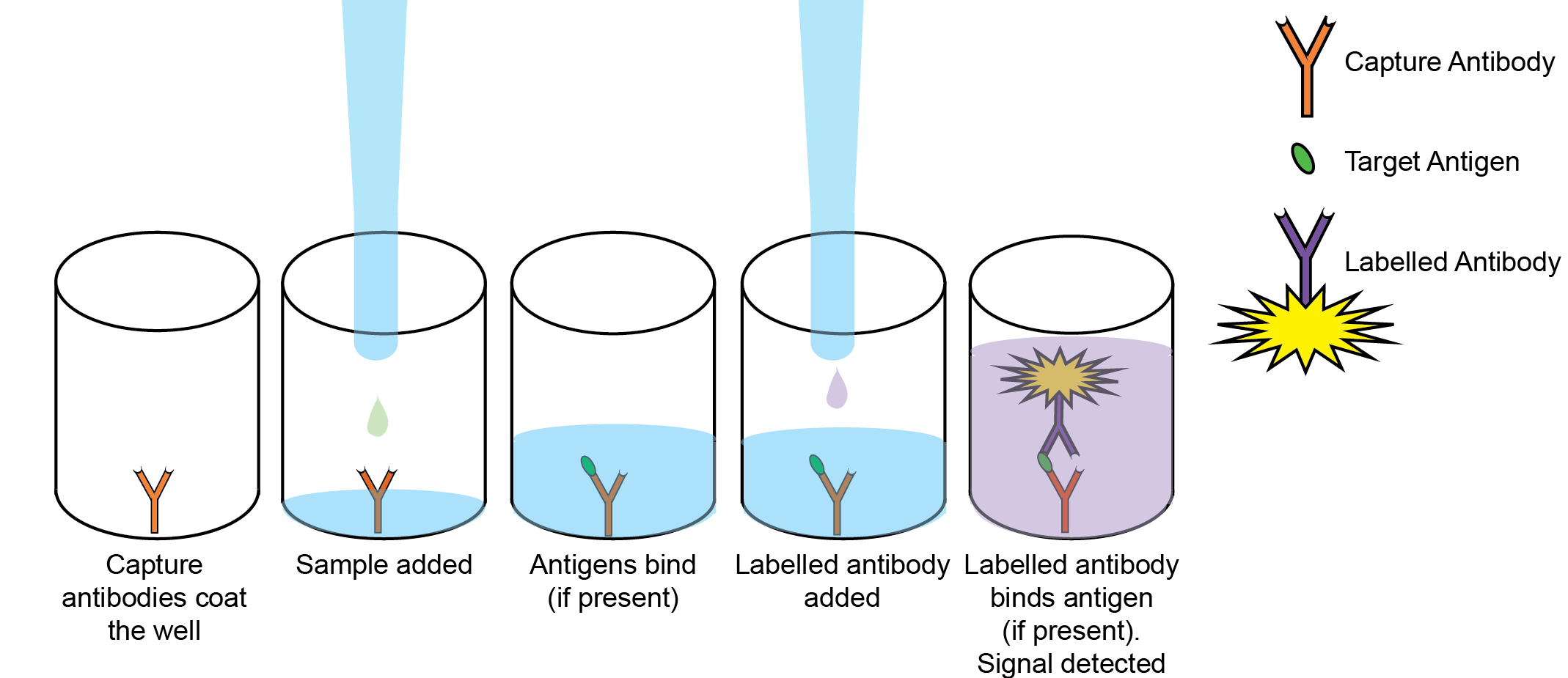
Figure 1. An overview of a standard ELISA protocol. A well plate is coated with capture antibodies that are highly specific to the antigen of interest. When a sample is added to a well, the antigen (if present) will bind to the capture antibody, and remain bound in subsequent rinse steps. A secondary detection antibody, which is conjugated to a molecular label, is then added and will bind specifically to the antigen-capture antibody complex if it is present. The label molecule allows the experimenter to easily visualize which wells contain the antigen of interest. Image created by Cindy Harley.
SCIENTIFIC TEACHING THEMES
Active Learning
During the lab, which is a classroom experiment, students are asked to make predictions about their results. Their predictions are then compared with the outcomes of the lab and they are asked to reflect on why the results differ from their original prediction, something found to increase retention (13). Since the lab is broken into several simulations, predictions can be acquired (and examine the validity of the previous prediction) between rounds.
Material can also be related to the real-world scenario of vaccines, specifically the influenza vaccine, something which gives the lesson context that is relatable.
Assessment
Students are given a handout (Supporting File S1: To vaccinate or not to vaccinate – Lab handout) which they use to guide them through the experiment process. Within the handout are several questions that are opened up for discussion. These questions are turned in as part of a lab report following class. There is also a survey element of the handout which asks students what they found most surprising from their data. The topics illustrated in this lab appear on an examination which covers the material.
Inclusive Teaching
This lesson was taught to a class of students that included 53% minorities and a majority of non-traditional students. This lesson aims to aid with cultural preconceived notions about vaccination, which are prevalent in the minority populations from which the students originate (14). This lesson provides a way to discuss vaccination with students who may have misconceptions. The lesson begins with a show of hands of when students think the vaccine will prevent disease spread. The informal poll shows students that they are not alone in their opinion, whatever it happens to be. As people differ in their beliefs about vaccination, discussion starts with the influenza vaccine because this is a vaccine that many people do not receive and there are a multitude of reasons used. This example has an added benefit as students have not been uncomfortable discussing their choice. However, an anonymous poll could be done online (for example, using Kahoot) to answer the questions 1) did you receive the influenza vaccine (flu shot)? 2) why or why not? 3) do you believe your choice affects others? We find that starting here establishes commonality and avoids exclusion of students whom may differ in their beliefs toward vaccination.
LESSON PLAN
Pre-Class Preparation
Creation of cabbage dye
A red cabbage is chopped into one-inch pieces which are then placed in to a pot and covered with water. A tablespoon of salt for every half cabbage is added. The mixture is then boiled for about 30-45minutes. The cabbaged is removed using a strainer while retaining the liquid. This experiment uses less than 40mL of this solution, the rest can be frozen into aliquots for later use.
Creation of baking soda solution (the infection)
A tablespoon of baking soda is placed into a 100mL beaker. 80mL of water is added. The mixture is then stirred and allowed to sit. The excess baking soda will settle to the bottom of the container. The liquid on the top is the super saturated baking soda solution which appears no different than water. It can be poured off the top and placed in another vessel.
Preparation of tubes
For each of the simulations, each student will need conical vial. These will be labelled with tape that has a unique number on it. For ease, they will be placed in a test tube rack. All but one vial will be filled with 10mL of distilled water; the last one will receive the 10mL of baking soda solution. The tube receiving the baking soda is randomized. Without randomization there is often an attempt to avoid the 'infected' tube. Through using different colors of tape each assay mixing of tubes can be avoided. A plastic transfer pipette is then placed into each of the tubes so that the students can use them to exchange fluids. Each round starts with only one 'infected' tube.
Vaccine
The vaccine is a pH 6 sodium citrate buffer. This is created by mixing 9.5mL of 0.1M citric acid with 41.5mL of 0.1M sodium citrate. 0.75mL of vaccine is enough for a 10mL tube. During the lab, it is important to not vaccinate patient zero as this will change results.
During Class Session
Lecture
Prior to this lesson, a short (20 min) lecture about immunity is given in which the differences between innate and adaptive immunity are explained. In the discussion of adaptive immunity, the role of antigens and antibodies in immunity is also discussed. As vaccines are involved in development of antibodies, this is something the students should be familiar with as well. Lecture slides can be found in (Supporting File S2. To vaccinate or not to vaccinate – Lecture slides).
Module 1
First, another short explanation of the direct ELISA and the procedure within the lab is given. The role of the first module is to acquaint the students with the procedure. Then, the first simulation is started by handing the students the numbered vials full of solutions. If there are an odd number of students, the instructor can join in as a participant. Make sure one student gets the 'infected vial' and that it is not the same number every time. The identity of the 'infected vial' should remain unknown to the students so they do not avoid the infected person. Then instruct students to match up with a partner – they will place approximately one-half pipette's worth of their solution into their partner's vial and receive an equal volume from their partner. Once this is complete, they will place a few drops of their solution in the first row (row A) of a 96 well plate in the column that corresponds to their tube number. They will then be able to find another partner and exchange fluids again. Following this exchange, they will place a few drops of their fluid into row C of the well plate (to avoid potential overflow contamination). The process repeats again with their third partner and them placing their sample into row E of the well plate. The instructor will then ask the students for their predictions which can be given as an individual or a group. They will then place the indicator in each of the wells with samples indicating healthy (purple) and infected (green) individuals (see Figure 2 for an example of class results). Results are written in a table on the board. Students will be asked if their results match the predictions that they made earlier which concludes the first simulation.
During the second simulation, students repeat the procedure from simulation 1 but, but this time engaging three partners per round instead of one. Since students have already walked through this once, this simulation tends to go a bit smoother than the first. Again, students are asked to give a prediction of their expected results, this is recorded both within their handout and a class prediction is written on the board. The experiment is carried out as above. Results are written on the board. Students are then asked if their prediction and the results match. This examination of the prediction relative to the actual results is used to initiate discussion.
When the cabbage dye is added to the samples it remains purple (no disease) or turns green (infected). Figure 2A shows the results of the simulation when students have had one partner per round (simulation 1). Figure 2B shows the results of the second simulation where they have three partners per round (simulation 2). In this example all of the wells have the infection by the final round of B. When the vaccine is introduced (Figures C and D; module 2), two uninfected individuals following 9 partners if 25% of the population is vaccinated (C) can be seen, and only two infected following 9 partners when 75% of the population receives the vaccine (D).
A wrap up discussion occurs where students are asked about the implications of this assay for disease transmission in familiar situations (rural communities, air planes, daycares, etc.).
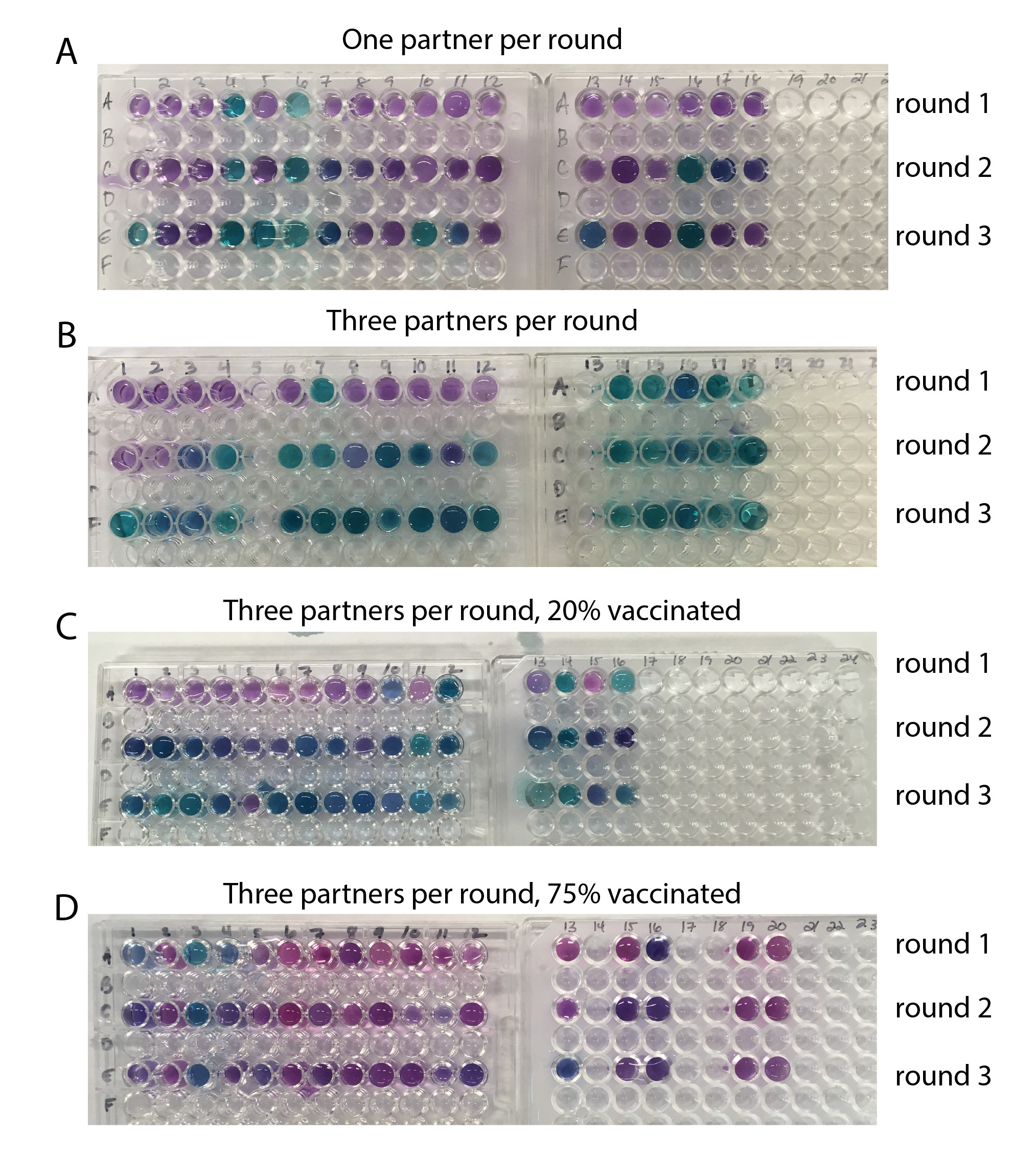
Figure 2. Sample results are clear indicators of the influence of contact and vaccination on disease spread. Well plates showing the results of the various simulations in Module 1 (purple dye= uninfected samples, green dye= infected samples). (A) Contact with 3 partner per round (=Simulation 1) results in slightly under 50% of students becoming infected by round 3. (B) Contact with three partners per round (=Simulation 2) results in a majority of students becoming infected early during the simulation, with a 100% infection rate observed by round 3. (C) When 20% of the population is vaccinated, a slight decrease in infection rate is observed. (D) When 75% of the population is vaccinated, a majority of students remain uninfected, even after contact with nine partners.
Module 2
Prior to the second module, students are asked if they received the influenza vaccine. The reasoning for this is that the influenza vaccine is a relatively innocuous way to discuss vaccination. Students discuss what their rationale was behind choosing to get the influenza vaccine or not. Reasons can be written on the board or projected if an anonymous polling mechanism such as Kahoot is used.
In the second module, a vaccine (buffer) is introduced using a pipettor to certain vials. The addition of the buffer prevents the reaction between the baking soda (virus) and the labelled antibody (cabbage dye). Students proceed with three partners per round for three rounds (as in the second simulation of module 1); however now 25% of them are vaccinated (see Figure 2C). Arbitrary things are chosen to determine which students receive the vaccine – birth date, first initial, last initial – whatever results in 25% participation. They are again asked to predict what they think the vaccine will do to the resulting assay prior to the addition of the cabbage dye. Once the cabbage dye is added, they are asked again whether their predictions match the results. Most commonly students assume that 25% vaccination will decrease disease spread; however, in a class of 24, it does not measurably do so. A short discussion in which the students suggest a rationale is recommended here. For the second simulation, the assay is then repeated with 50% of the class vaccinated. Once again, prior to revealing the results, students are asked to make a prediction and give a rationale for that prediction. When the results are revealed, they are written on the board and a discussion of their relationship to student predictions proceeds. Normally students predict that the disease spread will be greatly slowed, however, it is still able to spread far more than they typically expect. For the third simulation, 75% of the class is vaccinated (see Figure 2D). This simulation proceeds with the exact same format as the previous simulation. This time very few students should have the infection (2-3). Results are discussed within the class. Then we return to the discussion about the influenza vaccine.
Module 3
This module is discussion based. Depending on the class and level, the discussion for this module can change. An inevitable outcome is a discussion about the effectiveness of the influenza vaccine and why some years it is more effective than others. This will require the students to work through the basis of adaptive immunity and the response that occurs from vaccines. The instructor can discuss that the prominent strains of influenza vaccine are modeled (based on existing data) or that the immune response might not be as strong due to the construction of the vaccine. From here, there are a multitude of different discussions:
General
- Return to your article slide from the beginning (if applicable) and discuss why there was an outbreak of a disease citing the unvaccinated portion of the population.
- Discuss the origins of the myth that vaccines cause autism and remind the students of scientific ethics.
Lower division
- Discuss what would occur if part of the population had had the disease prior to this outbreak enhancing discussion of adaptive immunity.
- Discuss booster vaccines and why they occur.
Upper division
- Nasal (live-attenuated virus) vs injected (inactivated virus) vs toxoid vs subunit/recombinant/polysaccharide/conjugate vaccine shots and their effectiveness and side effects.
- Discuss the variables that need to be known to calculate the amount of the population that needs to be vaccinated in order to achieve eradication of the disease.
- Have students attempt to determine who was patient zero.
- Discuss properties that lead to diseases that are more likely to spread.
This discussion time allows students to not only understand the underpinnings of immunity better but also to dispel their misunderstanding of the role of vaccines in immunity.
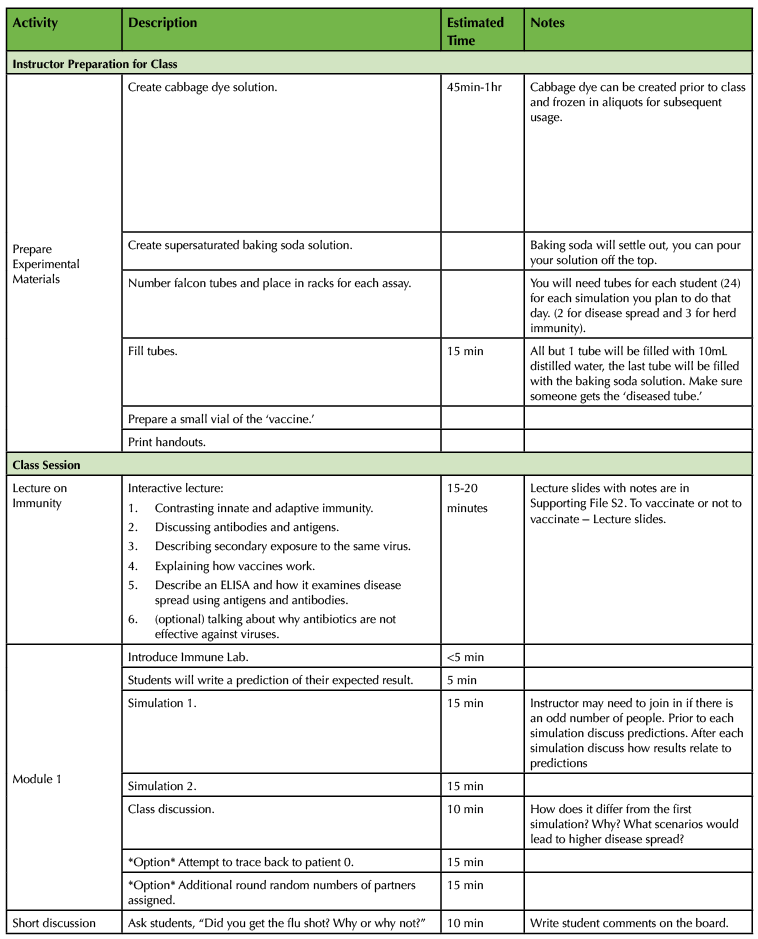
Table 1. A progression through the lesson illustrating instructor preparation and the timeline for each of the modules.
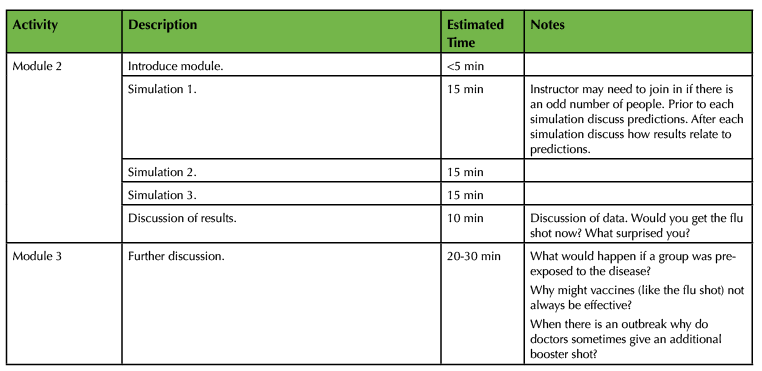
Table 1. A progression through the lesson illustrating instructor preparation and the timeline for each of the modules (continued).
TEACHING DISCUSSION
In this day and age of people choosing not to vaccinate themselves or others it is more important than ever to understand the effect that vaccination rates have on populations. This lesson illustrates that your choice to vaccinate not only effects your health but also that of surrounding people. Commonly, students predict that vaccines will slow the rate of infection far more than they actually do. In Spring 2018, at the conclusion of the activity, we asked our non-majors cohort (n=15) several questions with in an anonymized survey which was approved as exempt by our IRB: 1) how much they liked the activity on a scale of 1-10 (1 meaning "not at all" and 10 being "a lot"), 2) how surprised they were by the results on the same scale (Figure 3). The grand majority of students enjoyed the activity (Likert average 8.7, SD 1.9) and many were quite surprised by the result (Likert average 7.3, SD 2.38). At the end of the course, students are also asked to mark their favorite labs, this one often receives high marks. Having used the activity in a variety of classes, anecdotally, responses from majors and non-majors were similar. Most often the upper-level majors are surprised by the amount of the population that needs to be vaccinated for eradication.
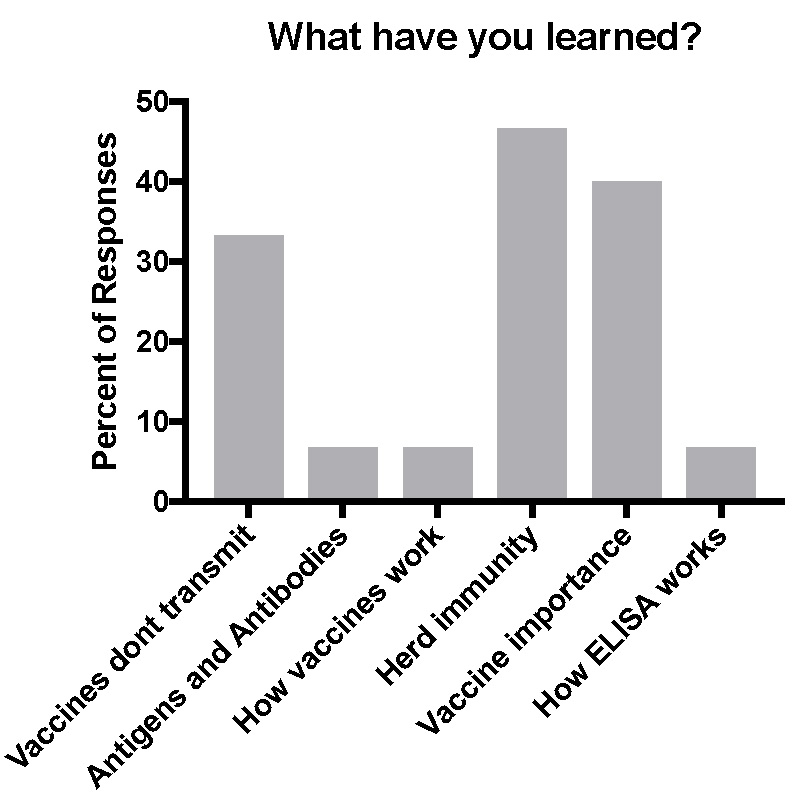
Figure 3. Student perceptions of the activity’s enjoyability and surprise factor. A vast majority of students indicated that they found the activity to be enjoyable (Likert average 8.7, SD 1.9, n=15). A majority of students also indicated that they found the results of the activity to be surprising relative to their expectations (Likert average 7.3, SD 2.38, n=15).
Students, on average, rated this activity high for enjoyment, but also stated that they were surprised by the outcome (Figure 3). First off, students are often not surprised by increased transmission with increased frequency of potential exposure, but they are often very surprised by how much infection rates increase with even a modest increase in the number of partners.
We became interested in what the students felt that they learned from the activity. Therefore, an additional free response question was added to the Spring 2018 non-majors biology survey: "what surprised you the most about your results" (Figure 3). Over 40% of students have remarked how amazed they were that the disease could persist even when the majority of the population was vaccinated. Furthermore, students had misconceptions about vaccines and how they work. This could be due to my particular population of students containing high numbers of representatives from cultures that do not traditionally vaccinate. The most surprising item for us was finding that a number of my students (over 30%) thought that vaccines themselves were transmissible through contact, something easily dispelled through this activity.
Representative quotes from survey of students in the 2018 non-science majors class include:
"It was shocking how quickly the disease spread without vaccination," "I understand how vaccines work a lot better and I was wondering about that," "I learned that I should get vaccinated," and "The more people vaccinated, the safer it is in the world as the virus won't spread as much," among other comments.
Student responses to the question regarding what they learned provided evidence that several learning objectives were met (Figure 4) whereby when asked 'what have you learned?', almost 50% discussed herd immunity, 40% discussed the importance of vaccines to their own health, and some discussed the mechanism of vaccine action. This question ascertained the most salient point to the student, so these results do not indicate everything that the student learned.
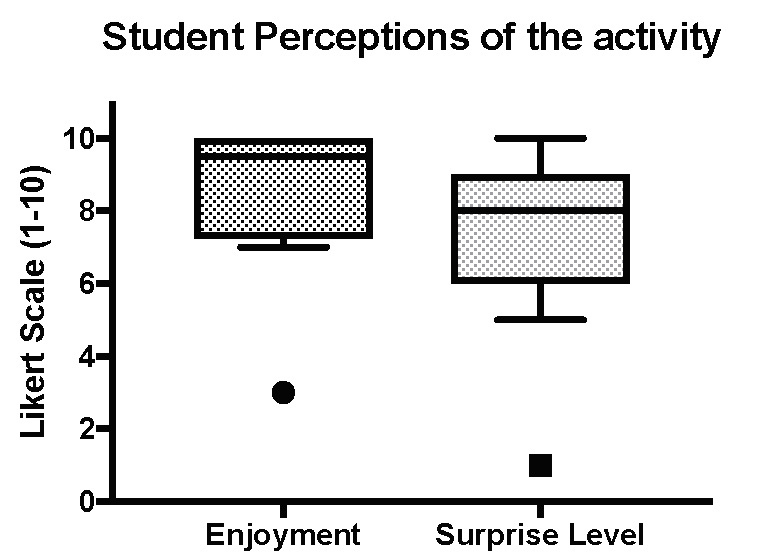
Figure 4. Student reports of what they learned. When asked to reflect on what they had learned during the activity, students provided a wide range of answers. Nearly 50% of the 17 respondents indicated that the activity helped them better understand the concept of herd immunity. Over 30% also indicated that the activity helped them learn more about the importance of vaccines and misconceptions about the risks of vaccination. Other concepts, including familiarity with antigens and antibodies, the mechanisms underlying vaccines, and the ELISA method were also represented.
Students (non-science majors) were asked what they felt they learned through this activity. Their responses were open-ended and tallied. The class was small, with only 17 students participating in the activity on that day.
This activity was designed to use simple materials available cheaply, for the most part, at the grocery store (baking soda, and red cabbage). The assay costs $175 for all materials, most are reusable (well plates, test tubes, test tube racks) and likely present in most classrooms. The non-reusable items (transfer pipettes, red cabbage, baking soda) come in large enough volume that they are enough for a large number of classes. However, through using these simple materials in this way, we are able to illustrate the idea of an ELISA, to give students the language of antigen and antibody, and to illustrate the concept of herd immunity. From there, we can expand the lesson to a variety of social, cultural, ecological, and evolutionary topics depending on the class. Potential expansions include:
- Discussion of influenza vaccine effectiveness which discusses why it may not work every year
- A case study of a vaccinated (or outbreak) population
- Creation of an informational flyer promoting vaccine use in the student's population of choice
- Calculation of the necessary vaccination rate needed to achieve eradication
- A discussion of how our direct ELISA differs from a true direct ELISA
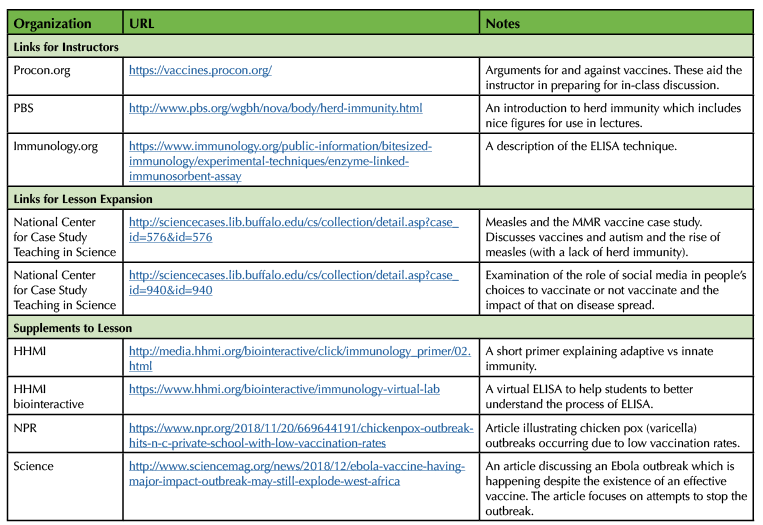
Table 2. A listing of helpful links for instructors and students including lesson expansions.
Vaccination is incredibly important to public health, but it is greatly misunderstood by a large portion of the population. Using this lab, we hope to help dispel some misunderstanding about vaccination, what it does, and what its role is in public health.
Even at the upper level, this activity provides a hands-on experience with herd immunity. Through changing the discussion topic, this assay can be effective in lower and upper division classes. In lower division classes, we tend to focus more on vaccinated people not getting sick and insulating others from the disease; a very basic concept here. In upper division classes, we talk about vaccine effectiveness – what items might lead to more effective vaccines, why might vaccines not work in some people, how does the modern world influence disease spread (for example, through travel), what are challenges to making an HIV vaccine. No matter the class level, relating this activity to a current case of an outbreak (which, sadly, are easy to find) gives the students a sense of how their coursework relates to the real world. Furthermore, perhaps by teaching students about vaccines we can help to dispel misunderstandings about them and quell the outbreaks.
SUPPORTING MATERIALS
- S1. To vaccinate or not to vaccinate – Lab handout
- S2. To vaccinate or not to vaccinate – Lecture slides
- S3. To vaccinate or not to vaccinate – Laboratory preparation procedure
ACKNOWLEDGMENTS
We would like to thank the students involved in the inspiration and creation of this lab exercise, the course source writing workshop instructors for their guidance and encouragement, and Kelly McDonald for her patience and guidance. A special thanks to Argosy publishing for allowing us to publish the handout we created for their instructor materials accompanying Visible Body courseware.
References
- Mullahy J. 1999. It'll only hurt a second? Microeconomic determinants of who gets flu shots. Health economics, 8: p. 9-24.
- Chen JY, Chen JY, Fox SA, et al. 2007;2006. Health disparities and prevention: Racial/ethnic barriers to flu vaccinations. Journal of Community Health, 32(1), 5-20. doi:10.1007/s10900-006-9031-7.
- McKee C, Bohannon K. 2016. Exploring the Reasons Behind Parental Refusal of Vaccines. J Pediatr Pharmacol Ther. 21(2): p. 104-9.
- Chi RC,Neuzil KM. 2004. The association of sociodemographic factors and patient attitudes on influenza vaccination rates in older persons. Am J Med Sci. 327(3): p. 113-7.
- Handy LK, Maroudi S, Powell M, et al. 2017. The impact of access to immunization information on vaccine acceptance in three countries. PLoS One. 12(8): p. e0180759.
- Nichol KL, Lofgren RP, Gapinski J. 1992. Influenza Vaccination Knowledge, Attitudes, and Behavior Among High-Risk Outpatients. Arch Int Med. 152: p. 106-110.
- Sugerman DE, Barskey AE, Delea MG, et al. 2010. Measles outbreak in a highly vaccinated population, San Diego, 2008: role of the intentionally undervaccinated. Pediatrics. 125(4): p. 747-55.
- Salathe M, Khandelwal S. 2011. Assessing vaccination sentiments with online social media: implications for infectious disease dynamics and control. PLoS Comput Biol. 7(10): p. e1002199.
- Fine PEM. 1993. Herd Immunity: History, Theory, Practice. Epidemiologic Reviews. 15(2): p. 265-302.
- Williams SE, Rothman RL, Offitt PA, Schaffner W, Sullivan M, Edwards KM. 2013. A randomized trial to increase acceptance of childhood vaccines by vaccine-hesitant parents: a pilot study. Acad Pediatr. 13(5): p. 475-80.
- Quadri-Sheriff M, Hendrix KS, Downs SM, Sturm LA, Zimet GD. 2012. The role of herd immunity in parents' decision to vaccinate children: a systematic review. Pediatrics. 130(3): p. 522-30.
- Simonsen L, Viboud C, Taylor RJ, Miller MA. 2011. The Epidemiology of Influenza and Its Control. Advances in Infectious Diseases, ed. R. Rappuoli and G.D. Giudice. Springer.
- Ambrose SA, Bridges MW, DiPietro M, Lovett MC, Norman MK. 2010. How learning works: Seven research-based principles for smart teaching. John Wiley & Sons.
- Bastani R, Glenn BA, Tsui J, Chang C, Marchand EJ, Taylor VM, Singhal R. 2011 Understanding suboptimal human papillomavirus vaccine uptake among ethnic minority girls. Cancer Epidemiology and Prevention Biomarkers, 20(7), 1463-1472.
Article Files
Login to access supporting documents
To Vaccinate or Not to Vaccinate(PDF | 638 KB)
S1. To vaccinate or not to vaccinate-Lab handout.docx(DOCX | 54 KB)
S2. To vaccinate or not to vaccinate-Lecture slides.pptx(PPTX | 20 MB)
S3.To vaccinate or not to vaccinate-Lab preparation procedure.doc(DOC | 42 KB)
- License terms

Comments
Comments
There are no comments on this resource.